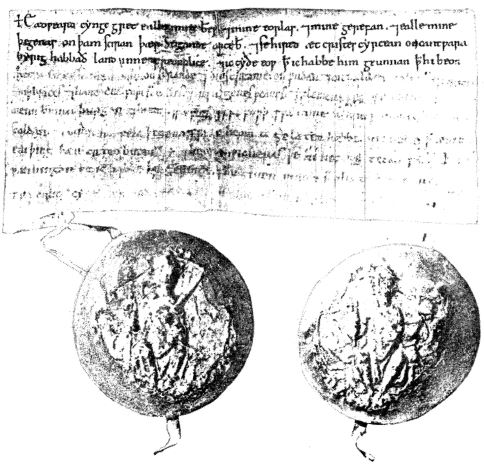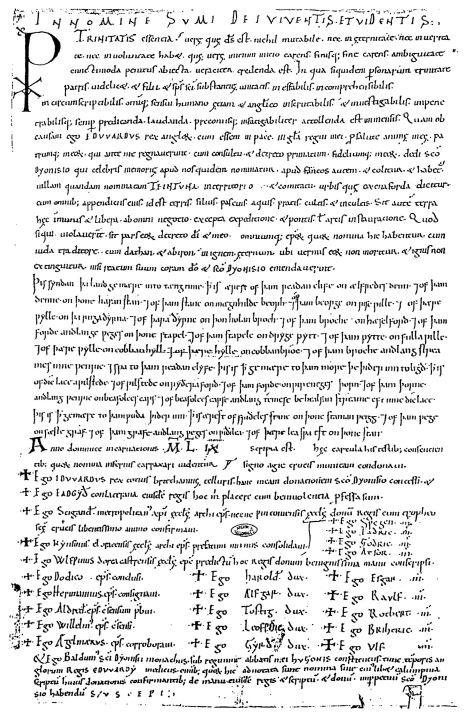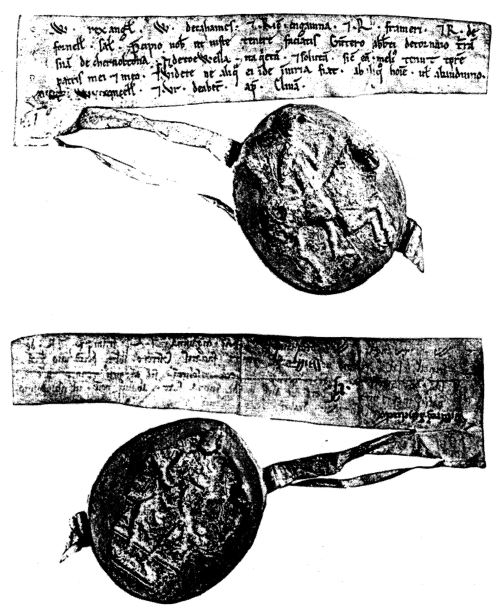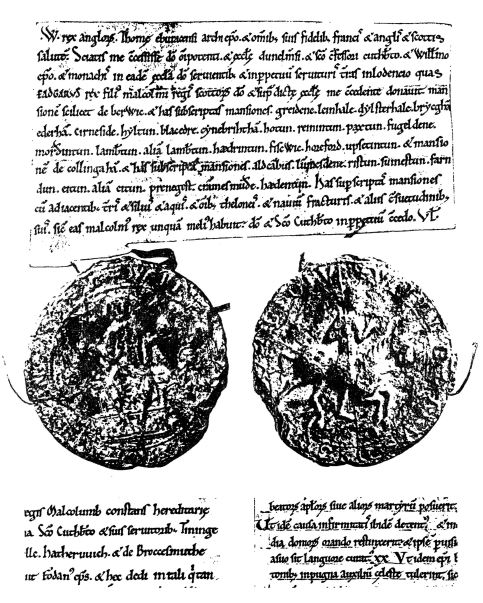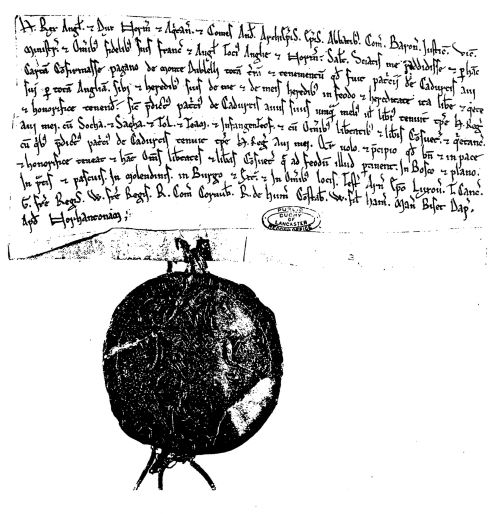[p. 189] The typology of English royal documents before 1200
(List)
1. Before 1066
A. Facsimiles and Handlist
All charters extant on single sheets of parchment written before the end of the eleventh century have now been published in facsimile:
E A BOND Facsimiles of Ancient Charters in the British Museum 4 vols. (1873–8); Ordnance Survey, Facsimiles of Anglo-Saxon Manuscripts 3 vols (1878–84) and Facsimiles of Anglo-Saxon Charters Supplementary Series vol. 1 by SIMON KEYNES (published for the British Academy by Oxford University Press 1991)
All charters are listed, with full references to manuscripts and printed texts, in P SAWYER Anglo-Saxon Charters: an Annotated List and Bibliography (1968); a supplement, and a revised edition are in preparation
S KEYNES Anglo-Saxon Charters: Archives and Single Sheets (forthcoming 1996 or 1997) will present a survey of all archives in which Anglo-Saxon charters have been preserved, and a classified list of all charters surviving on single sheets
B. Editions
New edition of entire corpus of Anglo-Saxon charters to supersede KEMBLE Codex Diplomaticus (1839–48) and W de GRAY BIRCH Cartularium Saxonicum (1885–93)
Fascicules so far published for British Academy by Oxford University Press
- Rochester ed A CAMPBELL (1973)
- Burton ed P SAWYER (1979)
- Sherborne ed M A O’DONOVAN (1988)
- St Augustine’s Canterbury ed S E KELLY (1995)
Shaftesbury, Barking and Selsey to be published shortly
Work in progress on Christ Church, Canterbury, Glastonbury, Wilton, Winchester Old Minster, Abingdon, Worcester
2. 1066–1154 (King William the Conqueror to King Stephen)
DAVID BATES “The Conqueror’s Charters” in ed C Hicks England in the Eleventh Century. Proceedings of the 1990 Harlaxton Symposium (Stamford 1992) [p. 190] 1–15 (Professor BATES is undertaking an edition of the Conqueror’s charters)
Regesta Regum Anglo-Normannorum vol. i 1066–1100 ed H W C DAVIS (Oxford 1913)
vol. ii Henry I 1100–1135 ed C JOHNSON & H A CRONNE (1956)
vol. iii 1135–54 Stephen, Matilda (& Geoffrey & Henry, dukes of Normandy) ed H A CRONNE and R H C DAVIS (1968)
vol. iv Facsimiles of vol. ii with diplomatic introduction (1969)
Writs
Facsimiles of English Royal Writs to A. D. 1100 presented to V H G GALBRAITH ed T A M BISHOP & P T V M CHAPLAIS (Oxford 1957)
R C van CAENEGEM Royal Writs in England from the Conquest to Glanvill (Selden Soc. 77, 1959)
D BATES “The earliest Norman writs” in English Historical Review 100 (1985)
P CHAPLAIS “Seals and originals of Henry I” in English Historical Review 75 (1960)
T A M BISHOP Scriptores Regis (Oxford 1961) – royal scribes of Henry I, Stephen and Henry II
3. 1154–1199 (King Henry II and King Richard I)
J C HOLT and R MORTIMER Acta of Henry II and Richard I: Handlist of Documents surviving in the Original in Repositories in the United Kingdom (List and Index Society Special Series 21, 1986) (Professor HOLT, with Dr MORTIMER, is undertaking an edition of Henry II’s charters, both originals and copies)
J C HOLT “The acta of Henry II and Richard I of England 1154–1199: the archive and its historical implications” in Historische Hilfswissenschaften I ed P RÜCK (Sigmaringen 1989)
R MORTIMER “The charters of Henry II: what are the criteria for authenticity ?” in Anglo-Norman Studies 12 ed M CHIBNALL (1990) 119–34
The Typology of English royal documents before 1200
I wish to make it clear that I am not an expert on English royal documents before 1200, my own speciality being papal diplomatic. I have, however, kept abreast of the work going on in my country, both as a matter of general interest and for teaching purposes, so this morning I want to outline the work of others undertaken in this field since the 1960s.1
There has been much activity in three main areas or periods, firstly the Anglo-Saxon period from before the Norman Conquest of 1066, secondly on the period of the Anglo-Norman monarchy between 1066 and 1154, covering the reigns of King William I, William II (Rufus), Henry I and Stephen, and thirdly, finally, on the [p. 191] period from 1154 to 1199 (the reigns of King Henry II and King Richard I) the Angevins. The diplomatic of English royal charters sits rather conveniently within the periods defined and I have divided both my paper and the accompanying list (above) into these three sections.
I begin with the Anglo-Saxon period, for which the first accepted original dates from 679 and is a charter of King Hlothhere of Kent (SAWYER 1968 no. 8). This is exceptionally early when one recalls that the earliest surviving complete papal document comes from 130 years later. The introduction of a documentary tradition has been associated with the arrival of Archbishop Theodore of Tarsus at Canterbury in 669. The case for St Augustine introducing the charter into England has been put by PIERRE CHAPLAIS, who, in a series of seminal articles in the 1960s on “The origin and authenticity of the royal Anglo-Saxon diploma”, “The Anglo-Saxon chancery: from the diploma to the writ” and “Some early Anglo-Saxon diplomas on single sheets: originals or copies ?”, began a re-evaluation of the evidence. There has been great activity on Anglo-Saxon diplomatic, too, since 1966 when a joint committee of the British Academy and the Royal Historical Society was set up to provide a new edition of the entire corpus of Anglo-Saxon charters to supersede two great nineteenth-century works, J. KEMBLE’S Codex Diplomaticus (1839–48) and W. de GRAY BIRCH’S Cartularium Saxonicum (1885–93). So far it has produced four volumes of fascicules for the churches and minsters of Rochester, Burton, Sherborne and St Augustine’s, Canterbury (published 1995). Shaftesbury, Barking and Selsey are promised shortly. Work is in progress on Christ Church, Canterbury, Glastonbury, Wilton, the Old Minster Winchester, Abingdon and Worcester. All volumes include comments on the archive as a whole and on the authenticity and language of the charters.
The outstanding work of SIMON KEYNES on The Diplomas of King Ethelred the Unready 978–1016 (Cambridge 1980), in which he argues for charters issued in the Witan and a definite royal chancery, will be known to some of you. And in the last year, 1991, his Facsimiles of Anglo-Saxon Charters, divided into three sections (1) charters written before c. 900 (2) charters written between the tenth and eleventh centuries and (3) charters written between c. 1100 and 1700, has completed the publication in facsimile of all charters extant on single sheets of parchment written before the end of the eleventh century, complementing E.A. BOND’S Facsimiles of Ancient Charters in the British Museum and the Ordnance Survey Facsimiles of Anglo-Saxon Manuscripts (both published in the nineteenth century). KEYNES provides detailed diplomatic analysis of the wealth of material here – diplomas, writs, wills and chirographs – and he will next provide Anglo-Saxon Charters: Archives and Single Sheets.
Of most interest for comparative purposes is the peculiarly English document the writ, of which we have examples from the end of the tenth century. Written in the vernacular, in a letter form, sealed on a tongue and undated, it was to determine much of the typology of royal documents after the Norman Conquest. (example 1). Diplomas issued, too, by Anglo-Saxon kings were in marked contrast to those of the [p. 192] continental kingdoms. They were not sealed, included subscriptions, but no symbols, beehives and so forth, and might include boundary clauses in the vernacular. (example 2 – Paris, Archives Nationales, Carton des rois AE 111 60 (K19, no. 6), 2 parts, diploma and writ)
Continuity, change and, of course, development are apparent in the second period, in the 90 years or so between the Norman Conquest and the last Anglo-Norman king, Stephen. The great strides of progress made here in diplomatic began with the publication in 1913 of the now much reviled first volume of the Regesta Regum Anglo-Normannorum which covered the reigns of the Conqueror and Rufus.
Professor DAVID BATES (to whom I owe the following information) is now engaged on a critical edition of the Conqueror’s charters. He has already reduced the number of acceptable texts to about 140 (not so very different in quantity from those issued under Edward the Confessor, for which KEYNES suggests 120+ and CLANCHY about 100). Few of these are, of course, originals. BATES has 60 or so documents not in the Regesta and has removed from it a quite significant number of forgeries. He has suggested the importance of continuing different diplomatic traditions – English, Norman, Mancean and Angevin – and has approved KEYNES’S suggestion that William the Conqueror’s English charters conform to a continuation of English practice before 1066, while William’s post 1066 Norman charters continue Norman traditions, Maine charters preserving Mancean traditions. Significant arguments of BATES concern the change and growth of the use of the writ after the Domesday Survey (1086), rather than after the Conquest, and an explosion in the issue of writs under Henry I for whom there are some 1000 for England, while only 88 for him as duke of Normandy for roughly the same period. (BATES “The earliest Norman writs” English Historical Review 100 (1985) 267). The Latin writ emerged under the Normans and was more frequently now an administrative order than a title deed. (examples 3 and 4). Under Henry I, too, the diploma fades as does the use of the vernacular. BATES’S point that the fusion of Anglo-Norman documentary tradition belongs to the twelfth century rather than to the eleventh century is of importance. BISHOP and CHAPLAIS’ pioneering work on English royal writs before 1100 and CHAPLAIS’ work on the seals and original documents of Henry I (English Historical Review 75, 1960 260–75) had already done much to change the emphasis of the study by demonstrating that many documents confidently dated to the Conqueror’s reign were in fact twelfth century productions. And Mr BISHOP’S detective work Scriptores Regis identified royal scribes of Henry I to Henry II, showing the move away from beneficiaries’ charters towards royal chancery productions, but no generic “official” script.
The third significant recent enterprise concerns our final period, 1154 to 1199, the reigns of Henry II and his son, Richard I. Professor HOLT (with the assistance of Dr MORTIMER) has undertaken the mammoth task to continue and enhance the earlier work on royal charters. As will be well known here, the monumental work of DELISLE and BERGER concerned the French provinces and [p. 193] “the affairs of France”. There are many more acts concerning England and it is HOLT’S intention to edit both originals and copies for both kings and their family, including Eleanor of Aquitaine and John as count of Mortain. It is the English Everest to be climbed. By the end of August 1986, 3196 documents had been identified, 2278 belonging to Henry II. HOLT suggests that the final total will probably be between 5000 and 6000. The items have been coded to indicate whether charter or writ, grant or confirmation and original or copy. They will have full diplomatic commentaries. There are rare bilingual charters from the beginning of Henry II’s reign, specialized legal writs from the end of Richard I’s reign. Only a very few letters close have survived: the tip of the iceberg perhaps of what may have been a major part of the Chancery scribes’ work. So far the originals of Henry II number 402 and these have been analysed by Dr MORTIMER. They include 17 acts not known to BISHOP (and 22 of Richard I not known to LANDON, who listed Richard’s charters in 1935). Dr MORTIMER has pointed out that the bulk of the surviving acta are from beneficiaries’ sources. He has produced detailed tables to show Chancery and non-Chancery production. The conclusions are as follows:
- Laymen and towns overwhelmingly use Chancery scribes.
- Chancery scribes wrote the majority of writs.
- The majority of general confirmations to a particular church are written by unidentified scribes.
- Specific confirmations are largely Chancery products.
Finally the documents from the first half of the reign outnumber those from the second by two to one, but non-Chancery production outnumbers Chancery production by 3 to 1. In short non-Chancery production becomes less common, especially of writs. And while writs and specific confirmations early in the reign were written by Chancery scribes, general confirmations were usually drawn up outside the Chancery by the beneficiaries themselves.
I can choose only one of Henry II’s charters to show as reasonably representative. (example 5). All the royal titles are cited. After May 1172 “dei gratia” was introduced. The address is to the ecclesiastics, nobility, king’s officers and subjects in that order. The greeting is “salutem” and the text commences “Sciatis me…”. The injunction “Quare volo” etc is also in the singular. The witnesses’ clause is completed by a place date. No year or day is given except in some charters written outside the Chancery.
Under Richard I there are important changes with the introduction of the plural from the time of the king’s coronation and the “data per manum” clause, reminiscent of that of the papal chancery and surviving until 1238. (example 6). It has been suggested that these changes are connected with the chancellorship of William Longchamps. Under Henry II the term “littere”, perhaps borrowed from ecclesiastical scribes, comes to be used for royal documents: by Richard’s reign perhaps “carta” was gaining the restrictive meaning of grant, while writ meant administrative order. Certainly by the end of the reign (1199), there is abundant evidence that royal chancery instruments were classified into “carte”, “littere [p. 194] patentes” and “littere clause”, which determined the enrolment divisions. There is scope for much more investigation now that the collection of the material has taken place. Certainly I hope in my retirement in the early years of the twenty-first century to be able to answer on the basis of other people’s work many of the questions that will doubtless be in your minds today.
[p. 195]